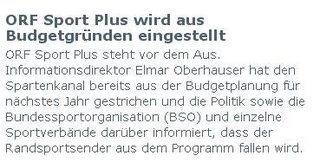
Hartnäckigkeit kann man dem
Verein gegen Tierfabriken Schweiz (VgT) wirklich nicht absprechen - der vor zwanzig Jahren gegründete Verein verfolgt seine Ziele mit äußerster Konsequenz, nicht zuletzt auch in seinen Medienkampagnen. Nun hat der VgT ein zweites Mal vor dem Europäischen Gerichtshof für Menschenrechte (EGMR) Recht bekommen und eine weitreichende Grundsatzentscheidung herbeigeführt.
Die Vorgeschichte geht in das Jahr 1994 zurück. Damals lehnte das Schweizer Fernsehen die Ausstrahlung eines VgT-Werbespots ab, in dem unter anderem die Massenhaltung von Schweinen mit Zuständen in Konzentrationslagern verglichen wurde. Der VgT schöpfte alle innerstaatlichen Rechtsmittel bis hin zum Bundesgericht aus, blieb aber - wegen des in der Schweiz geltenden Verbots politischer Werbung im Fernsehen - erfolglos.
Der EGMR stellte allerdings in seinem
Urteil vom 28. Juni 2001, VgT gegen Schweiz, eine Verletzung des Art 10 EMRK fest. Wörtlich heißt es in diesem Urteil unter anderem:
"In the Court’s opinion ... the domestic authorities have not demonstrated in a 'relevant and sufficient' manner why the grounds generally advanced in support of the prohibition of political advertising also served to justify the interference in the particular circumstances of the applicant association’s case.
... It therefore mattered little that the pictures and words employed in the commercial at issue may have appeared provocative or even disagreeable."
Im Lichte des nun vorliegenden zweiten
Urteils des EGMR vom 30. Juni 2009 in Sachen VgT gegen Schweiz (Nr. 2) sind aus dem ersten
Urteil vom 28. Juni 2001 noch folgende Passagen hervorzuheben:
"The Government have also submitted that admitting the applicant association’s claim would be to accept a 'right to broadcast' which in turn would substantially interfere with the rights of the Commercial Television Company to communicate information. ... The Court recalls that its judgment is essentially declaratory. Its task is to determine whether the Contracting States have achieved the result called for by the Convention. ... It is not the Court’s task to indicate which means a State should utilise in order to perform its obligations under the Convention". (Betonung hinzugefügt)
Der VgT ließ es nicht mit dem feststellenden Urteil des EGMR bewenden, sondern versuchte beim Schweizer Bundesgericht die Wiederaufnahme des Verfahrens zu erreichen und die Ausstrahlung des Werbespots aus dem Jahr 1994 durchzusetzen. Das Bundesgericht gab diesem Begehren keine Folge, gestützt vor allem auf eine im Einzelnen dargelegte verfahrensrechtliche Argumentation, aber auch unter Hinweis darauf, dass es dem VgT wohl weniger um die Ausstrahlung des alten Werbespots gehe als um die Öffentlichmachung des EGMR-Urteils, in dem eine Verletzung des Rechts des VgT auf freie Meinungsäußerung festgestellt wurde.
Gegen die negative Entscheidung des Bundesgerichts über die Wiederaufnahme des Verfahrens wandte sich der VgT neuerlich an den EGMR. Mit
Urteil der 5. Kammer des EGMR vom 4. Oktober 2007 wurde festgestellt, dass die Weigerung, das Verfahren wieder zu eröffnen, eine neuerliche Verletzung des Art 10 EMRK darstellte. Die Schweizer Regierung beantragte daraufhin eine Entscheidung durch die Große Kammer des EGMR, die nun im
Urteil vom 30. Juni 2009, VgT gegen Schweiz (Nr. 2), jedoch - mit 11 zu 6 Stimmen - zum selben Ergebnis kam (siehe dazu auch die
Presseaussendung des EGMR).
Hätte sich das Bundesgericht auf eine rein prozedurale Argumentation zurückgezogen, wäre es vielleicht nicht zur neuerlichen Verurteilung der Schweiz durch den EGMR gekommen - der Hinweis auf das (angeblich) weggefallene Interesse des VgT an der Ausstrahlung des alten Werbespots eröffnete dem EGMR allerdings einen Ansatzpunkt:
"The Court observes in particular that in dismissing the application to reopen the proceedings, the Federal Court mainly relied on new grounds, namely that because of the time that had elapsed, the applicant association had lost all interest in having the commercial broadcast. By comparison, one of the main arguments put forward by the domestic authorities in refusing permission to broadcast the commercial in the first set of proceedings brought by the applicant association related to the prohibition of political advertising. Accordingly, in the opinion of the Federal Court itself, the general context had evolved to such an extent that it was legitimate to wonder whether the applicant association still had an interest in broadcasting the commercial. That is sufficient to warrant the conclusion that the refusals received after the Court's judgment of 28 June 2001 constitute relevant new information capable of giving rise to a fresh violation of Article 10."
Und auch inhaltlich gab es für die Schweiz in der Sache nichts zu gewinnen - hier die wesentlichen Passagen aus der Begründung des EGMR:
"92. The Court reiterates that there is little scope under Article 10 § 2 of the Convention for restrictions on political speech or, as in this case, on debate of questions of public interest ... This applies all the more in the instant case, having regard to the Court's judgment of 28 June 2001. Moreover, the television commercial concerned battery pig-farming. Accordingly, as it related to consumer health and to animal and environmental protection, it was undeniably in the public interest.
93. The Court further notes that the television commercial was never broadcast, even after the Court's judgment had found that the refusal to broadcast it infringed freedom of expression. However, prior restraints on publication entail such dangers that they call for the most careful scrutiny ...
94. Furthermore, the Court has already found, in its judgment of 28 June 2001, that the interference in issue was not necessary in a democratic society, among other reasons because the authorities had not demonstrated in a relevant and sufficient manner why the grounds generally advanced in support of the prohibition of “political” advertising could serve to justify the interference in the particular circumstances of the case (see Verein gegen Tierfabriken (VgT), cited above, § 75). The Federal Court subsequently dismissed the applicant association's application to reopen the proceedings on the ground that the association had not provided a sufficient indication of its position as to the nature of “the amendment of the judgment and the redress being sought”, as it was formally required to do by section 140 of the former Federal Judicature Act (see paragraph 29 above). On this point, the Grand Chamber shares the view expressed in paragraph 62 of the Chamber judgment that this approach is overly formalistic in a context in which it is clear from the circumstances as a whole that the association's application necessarily concerned the broadcasting of the commercial in question, which had been prohibited by the Federal Court itself on 20 August 1997.
95. The Federal Court further held that the applicant association had not sufficiently shown that it still had an interest in broadcasting the commercial. As the Chamber observed in paragraph 62 of its judgment, the Federal Court thereby took the place of the applicant association, which alone was competent at that stage to judge whether there was still any purpose in broadcasting the commercial. The Grand Chamber shares that view. It further observes that the public interest in dissemination of a publication does not necessarily decrease with the passing of time (see, to similar effect, Editions Plon v. France, no. 58148/00, § 53, ECHR 2004-IV). Moreover, the Federal Court did not offer its own explanation of how the public debate on battery farming had changed or become less topical since 1994, when the commercial was initially meant to have been broadcast. Nor did it show that after the Court's judgment of 28 June 2001 the circumstances had changed to such an extent as to cast doubt on the validity of the grounds on which the Court had found a violation of Article 10. ...
96. Furthermore, the argument that the broadcasting of the commercial might be seen as unpleasant, in particular by consumers or meat traders and producers, cannot justify its continued prohibition. The Court reiterates in this connection that freedom of expression is applicable not only to “information” or “ideas” that are favourably received or regarded as inoffensive or as a matter of indifference, but also to those that offend, shock or disturb. Such are the demands of pluralism, tolerance and broadmindedness without which there is no “democratic society” ...
97. The Court notes, lastly, that the Contracting States are under a duty to organise their judicial systems in such a way that their courts can meet the requirements of the Convention (see mutatis mutandis, Bottazzi v. Italy [GC], no. 34884/97, § 22, ECHR 1999-V, and the case-law cited therein). This principle also applies to the execution of the Court's judgments. Accordingly, it is equally immaterial in this context to argue, as the Government did, that the Federal Court could not in any event have ordered that the commercial be broadcast following the Court's judgment. The same is true of the argument that the applicant association should have instituted civil proceedings."
Zum materiellen Gehalt des Art 10 EMRK bringt das neue EGMR-Urteil nicht viel Neues, sondern im Kern bloß die Bestätigung des ersten VgT-Urteils aus dem Jahr 2001 (zu dem nach Art 10 EMRK unzulässigen gänzlichen Verbot politischer Werbung im Fernsehen siehe inzwischen auch den Fall
TV Vest, siehe dazu
hier). Von weit reichender Bedeutung aber sind die Aussagen zu den Verpflichtungen der Konventionsstaaten im Hinblick auf die Umsetzung von Entscheidungen des EGMR, die weit in die Organisation des Gerichtswesens hineinreichen.
Labels: Art_10_EMRK, EGMR, Medienrecht, Rundfunkrecht
 Nach dem österreichischen Strafgesetzbuch begeht einen Raub, "wer mit Gewalt gegen eine Person oder durch Drohung mit gegenwärtiger Gefahr für Leib oder Leben (§ 89) einem anderen eine fremde bewegliche Sache mit dem Vorsatz wegnimmt oder abnötigt, durch deren Zueignung sich oder einen Dritten unrechtmäßig zu bereichern". Postraub - also ein Raub, der auf die Wegnahme von Sachen wie zB Briefen oder Geld gerichtet ist, die sich im Gewahrsam der Post befinden - ist in Österreich, anders als zB in den USA, kein besonders qualifiziertes Delikt.
Nach dem österreichischen Strafgesetzbuch begeht einen Raub, "wer mit Gewalt gegen eine Person oder durch Drohung mit gegenwärtiger Gefahr für Leib oder Leben (§ 89) einem anderen eine fremde bewegliche Sache mit dem Vorsatz wegnimmt oder abnötigt, durch deren Zueignung sich oder einen Dritten unrechtmäßig zu bereichern". Postraub - also ein Raub, der auf die Wegnahme von Sachen wie zB Briefen oder Geld gerichtet ist, die sich im Gewahrsam der Post befinden - ist in Österreich, anders als zB in den USA, kein besonders qualifiziertes Delikt.








